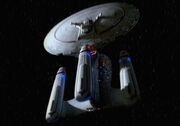
An alternate future version of the USS Enterprise-D, with three warp nacelles.
A warp nacelle is an outboard structure found on warp capable vessels. Vessels with warp drive will typically have two or more nacelles, although some vessels function with a single nacelle. A warp nacelle has also been referred to as a warp pontoon, especially on starship classes that lacked pylons such as the Danube-class or the Nebula-class, due to the visual similarity to the pontoon floats on water-going ships.
History and specifications[]
Warp nacelles contain a number of field coils which create a warp field when injected with highly energetic warp plasma, or plasma created in the warp core by the reaction of deuterium and antideuterium, mediated through an assembly of dilithium crystals, which are nonreactive with antimatter when subjected to high-frequency electromagnetic fields. The warp nacelle is connected to the warp core via plasma transfer conduits, which transferred the plasma in the core to the nacelles. Because the radiation produced by a nacelle was detrimental to living beings, the nacelle was usually placed at some distance from the main structure of the vessel, and held in place with a pylon.
On Starfleet vessels, nacelles often have a Bussard ramscoop at the front of the nacelle, which gathers hydrogen for use in power generation.
Studies by the United Federation of Planets found that two nacelles were the optimum number for creating the most efficient warp field, as well as for vessel control. (TNG reference: Star Trek: The Next Generation Technical Manual)
However, the Federation has fielded vessels with only one nacelle, such as the Saladin-class, or three or more nacelles, such as the three-nacelled Federation-class. (ST reference: Star Fleet Technical Manual)
In the 24th century, a variant of the Galaxy-class starship was fitted with a third nacelle. (TNG video game: Birth of the Federation; ST video game: Star Trek Online)
In an anti-time future, the USS Enterprise-D had been refit as a Galaxy X-class vessel with a third nacelle. (TNG episode: "All Good Things...")
Nacelle vulnerability[]
Although warp nacelles are attached to the ship with extremely strong housings and shored up by structural integrity fields, it is a potential vulnerability to attack to have the nacelles severed or skewed out of place. If a ship traveling at warp were to lose a nacelle it would result in the vessel's destruction as different parts of the ship would be traveling at different warp factors. (TNG reference: Star Trek: The Next Generation Technical Manual)
A ramming attack by the Ravens in 2268 changed the geometry of one of the Federation starship USS Enterprise's nacelles, disabling the ship from engaging a warp field. (TOS novel: Dreams of the Raven)
While battling the USS Reliant in the Mutara Nebula in 2285, Rear Admiral James T. Kirk ordered a photon torpedo barrage to be launched by the Enterprise. One of Reliant's warp nacelles was directly hit by a torpedo, fracturing the unit and separating the bulk of the nacelle from Reliant, with the power feedback causing multiple explosions throughout the ship. (TOS movie, novelization & comic adaptation: The Wrath of Khan)
In the year 2368, a time loop caused the USS Enterprise-D to repeatedly collide, nacelle to nacelle, with the USS Bozeman, in the Typhon Expanse. In each occurrence (except the last time the ship and crew faced the time loop), the direct strike shattered the plasma containment in the Enterprise-D's nacelle, causing an uncontrolled venting of plasma that led to a warp core breach. (TNG episode: "Cause and Effect")
When Krall ordered his drone fleet against the Kelvin timeline USS Enterprise, he specifically directed a major ramming attack against the nacelle struts of the Enterprise, completely severing both units and effectively rendering the vessel immobile from escaping at warp speeds. (ST movie: Beyond)
External links[]
- Warp nacelle article at Memory Alpha, the wiki for canon Star Trek.

